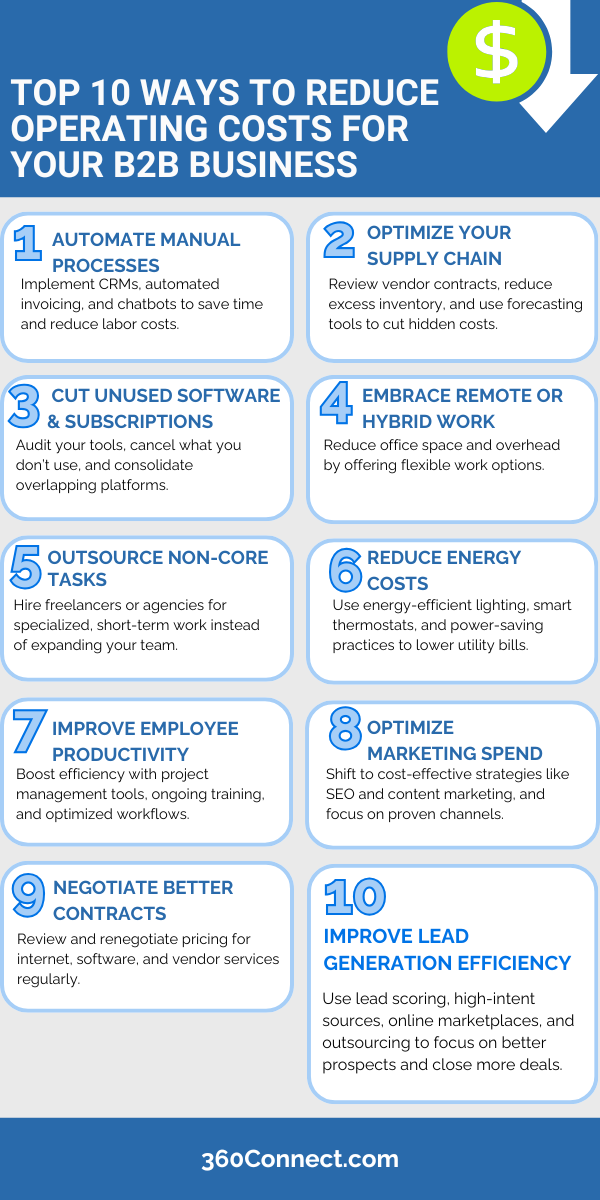Operating costs can quickly eat into your bottom line if left unchecked. Whether it’s high overhead, inefficient processes, or unnecessary expenses, every dollar saved on operations is a dollar that can be reinvested into growth. The key is knowing how to reduce operational costs without sacrificing quality or performance.
If you’re looking for ways to reduce expenses and improve efficiency, you’re in the right place. Let’s break down what operating costs are, when you need to cut them, and ten actionable ways to reduce them in your B2B business.
What are Operating Costs?
Operating costs (or operational expenses) are the day-to-day expenses required to keep your business running. These include things like:
- Rent, utilities, and office expenses
- Employee wages and benefits
- Inventory and supply chain costs
- Software, technology, and maintenance
- Marketing, advertising, and sales operations
- Travel, training, and administrative costs
Unlike capital expenses (which cover long-term investments like equipment or real estate), operating costs directly impact cash flow and profitability. Keeping these expenses in check ensures your business remains competitive and financially stable.
Do You Need to Reduce Operational Costs?
Not all cost-cutting is good cost-cutting. Some expenses are necessary to grow your business, so it’s important to evaluate whether you actually need to reduce operational costs before making changes. Ask yourself:
- Are profit margins shrinking due to rising costs?
- Are overhead costs too high compared to revenue?
- Are you paying for tools, software, or services you don’t fully utilize?
- Are manual processes slowing down efficiency?
- Is your cash flow struggling due to excessive expenses?
If you answered yes to any of these, it’s time to take a closer look at where you can optimize spending.
How to Reduce Operational Costs for Your B2B Business
Cutting costs doesn’t have to mean sacrificing what makes your business work. It’s about finding better, more efficient ways to run your operations. Let’s break down how to make that happen.
Top 10 Ways to Reduce Operational Costs

1. Automate Manual Processes
The easiest way to reduce operational costs? Automate.
Indeed, automating manual processes can significantly reduce operating costs. Although it may not seem that way because you’ll need to make initial investments, automation pays for itself quickly by saving time, reducing human error, and letting your team focus on more meaningful work.
A McKinsey study found that companies that adopt automation can boost productivity by 30% within a few years
If your team is still manually inputting data, sending follow-up emails, or handling tasks that a machine could do faster and better—it’s time to stop. Implement tools that take care of the repetitive stuff: CRMs that manage lead tracking, automated invoicing systems, AI chatbots that answer FAQs. Less time spent on manual labor means lower labor costs and faster workflows.
Look at areas like:
- Customer follow-ups and email drip campaigns
- Lead qualification and sales tracking
- Data entry and reporting
Related: How to Grow Your Business With Marketing Automation
2. Optimize Your Supply Chain
Your supply chain could be quietly bleeding your budget.
If you haven’t looked at your suppliers, shipping costs, or inventory turnover in a while—start there. A disorganized or bloated supply chain creates unnecessary expenses. You might be overpaying for materials, ordering more than you need, or dealing with unreliable vendors that cost you time (and time is money).
Start by reviewing your vendor agreements. Negotiate better terms or bulk discounts. Use inventory management software to prevent overstocking and reduce holding costs. And if you’re still tracking shipments with spreadsheets—it’s time to upgrade.
Quick wins:
- Switch to vendors with more favorable pricing or terms
- Streamline your delivery process to reduce freight costs
- Use AI or forecasting tools to fine-tune inventory
3. Cut Unused Software & Subscriptions
Let’s be honest: you probably have software you’re not even using.
Many businesses pay hundreds—sometimes thousands—a month on tools they signed up for and forgot about. Or worse, they’re using five different platforms that all do the same thing. It’s like paying for both Netflix and Hulu and only watching YouTube.
Conduct a tech audit. What software do you actually use daily? What tools have overlapping functions? Consolidating or canceling unused services can make a huge dent in your monthly expenses—without impacting operations.
What to do to reduce operational costs:
- Cancel tools you haven’t logged into in months
- Combine platforms when possible
- Downgrade plans if you’re not using all the features
4. Embrace Remote & Hybrid Work
Remote work isn’t just a perk—it can be a cost-saver.
If your business model allows it, giving employees the flexibility to work from home even part-time can significantly reduce overhead. Less office space, fewer utility bills, and reduced office supply costs. Not to mention the boost in productivity that often comes with flexible work environments.
You don’t have to go fully remote. Even a hybrid model can give you room to cut costs. Downsizing your office space or switching to a co-working setup could save thousands a year.
Easy savings:
- Trim your lease or switch to a smaller office
- Cut back on utilities, snacks, and in-office extras
- Use virtual meeting tools instead of travel
5. Outsource Non-Core Tasks
You don’t need a full-time employee for every single role.
For occasional projects or specialized tasks, outsourcing can be way more cost-effective than bringing someone on payroll. Think about the things that don’t need daily attention—just a solid expert to knock it out once and move on.
Plus, freelancers and agencies often bring in niche skills that would take months (and more money) to build in-house. Keep your core team focused on what they do best, and outsource the rest when it makes sense.
Tasks worth outsourcing to reduce operational costs:
- One-off ad campaign creation
- Market research for a new initiative
- Product photography
6. Reduce Energy Costs
Utility bills aren’t the flashiest topic, but the costs add up fast.
Small upgrades can make a big impact on your monthly energy bill. Switching to energy-efficient lighting, investing in smart thermostats, and ensuring equipment isn’t running 24/7 when it doesn’t need to be—all of that contributes to long-term savings.
It’s not just about cutting costs—it’s also a selling point for eco-conscious clients. Lower your overhead and improve your green image? That’s a win-win.
Quick ideas to reduce operational costs:
- Use LED lights and energy-efficient appliances
- Program thermostats to reduce waste
- Power down equipment when not in use
7. Improve Employee Productivity
A slow, inefficient team can cost more than you think.
Improving productivity isn’t about putting more pressure on employees—it’s about giving them the support and structure they need to thrive. With the right tools, training, and workflows, your team can get more done in less time—and without burning out.
The more efficient your team is, the more you’ll accomplish without needing to grow your headcount.
What helps:
- Project management tools like Asana or Trello
- Ongoing training and development
- Regular team check-ins to clear bottlenecks
8. Optimize Your Marketing Spend
Marketing doesn’t have to be expensive to be effective.
If you’re spending big on ads but not seeing much return, it might be time to scale back and refocus. Start by identifying what channels are actually delivering results. If you’re not tracking ROI, you’re basically throwing spaghetti at the wall.
Consider leaning into lower-cost, high-impact strategies like SEO, content marketing, and email nurturing. These take time but generate compounding results. Less waste. Better leads.
Cost-saving ideas:
- Shift from paid ads to organic strategies
- Repurpose existing content instead of creating from scratch
- Use analytics to double down on what’s working
9. Negotiate Better Contracts
Everything is negotiable—yes, even that.
Whether it’s your internet service, lease, vendor agreements, or SaaS subscriptions, there’s almost always room to negotiate. Many providers would rather offer you a discount than lose your business altogether.
Review your contracts annually and don’t be afraid to shop around. You might be surprised at how much leverage you actually have—especially if you’re a long-time customer.
Things to renegotiate:
- Internet, phone, and office services
- Vendor pricing and supply terms
- Software and subscription renewals
10. Improve Lead Generation Efficiency
Not all leads are created equal—and low-quality leads waste your time and money.
If your sales team is spending hours chasing dead-end prospects, it’s time to rethink your lead generation strategy. The goal is to generate fewer, better leads that are more likely to convert. That’s where smart targeting, better qualification, and outsourcing can help.
You don’t need to cast a wider net—you need a smarter one. Use tools that filter and score leads so your team can focus on closing, not chasing.
How to tighten your funnel:
- Use lead scoring or AI-based qualification
- Invest in high-intent lead sources
- Outsource to a lead gen service that filters prospects for you
Why This Matters for B2B Businesses
Reducing operational costs isn’t just about cutting expenses—it’s about maximizing efficiency and ensuring your business remains profitable, even in uncertain economic conditions. The money you save can be reinvested into business growth, innovation, and customer experience improvements.
Businesses that regularly audit their spending, embrace technology, and optimize processes will always have a competitive advantage over those stuck with outdated, inefficient operations.
Final Thoughts on How to Reduce Operational Costs
There’s no one-size-fits-all solution to cutting costs, but small changes add up. By automating processes, negotiating better contracts, optimizing supply chains, and focusing on high-ROI strategies, you can reduce expenses while keeping your business strong.
If you’re serious about cutting costs and improving your bottom line, start by evaluating where your money is going and make data-driven decisions to improve efficiency.
Save Time & Money with High-Quality Leads
At 360Connect, we help B2B businesses connect with high-intent buyers who are ready to purchase. Instead of wasting resources on cold outreach, get matched with real buyers looking for your products and services today.

